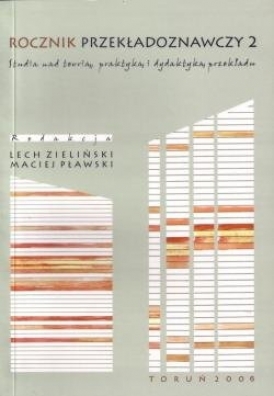Przesunięcia w obrębie leksykalnego schematu kohezywnego w tłumaczeniu symultanicznym i konsekutywnym
DOI:
https://doi.org/10.12775/RP.2006.008Słowa kluczowe
tłumaczenie, tłumaczenie ustne, tłumaczenie symultaniczne, tłumaczenie konsekutywne, przesunięcia, schemat kohezywnyAbstrakt
Niniejszy artykuł podejmuje próbę analizy przesunięć w obrębie leksykalnego schematu kohezywnego w procesie tłumaczenia symultanicznego i konsekutywnego. Biorąc pod uwagę odmienną specyfikę tych dwóch różnych typów tłumaczenia konferencyjnego, można spodziewać się znacznych rozbieżności, jeżeli chodzi o oddanie środków więzi w tekstach docelowych. Analiza została przeprowadzona na podstawie kryteriów ograniczeń typowych dla tłumaczenia ustnego (Interpreting Constraints): ograniczenia czasowego (The Time Constraint), wymogu linearności wypowiedzi (The Linearity Constraint), ograniczenia wynikającego z braku wspólnego kontekstu komunikacyjnego (The (Un)shared Knowledge Constraint) oraz ograniczenia ze względu na pojemność pamięci (The Memory Load Constraint).Bibliografia
Baker, M. 1992, In Other Words: A Coursebook on Translation, London–New York.
Blum-Kulka, S. 1986, Shifts in Cohesion and Coherence in Translation, [w:] Interlingual and Intercultural Communication: Discourse and Cognition in Translation and Second Language Acquisition Studies, red. J. House i S. Blum-Kulka, Tübingen, s. 17–35.
Gajda, S. 1982, Podstawy badań stylistycznych nad językiem naukowym, Warszawa–Wrocław.
Gile, D. 1995, Basic Concepts and Models for Interpreter and Translator Training, Amsterdam–Philadelphia.
Gile, D. 1997, Conference Interpreting as a Cognitive Management Problem, [w:] Cognitive Processes in Translation and Interpreting, red. J. Danks i in., London, s. 196–214.
Gile, D. 2001, The Role of Consecutive in Interpreter Training: A Cognitive View (http://www.aiic.net/ViewPage.cfm/page377.htm).
Gumul, E. 2004, Cohesion in Interpreting, niepubl. pr. dokt., Uniwersytet Śląski, Katowice.
Gumul, E. 2005, EVS: czynnik czasu w tłumaczeniu symultanicznym, [w:] Czas w języku i kulturze, red. A. Arabski, E. Borkowska i A. Łyda, Katowice, s. 176–183.
Halliday, M. A. K., Hasan, R. 1976, Cohesion in English, London–New York.
Hatim, B., Mason, I. 1990, Discourse and the Translator, London–New York.
Hatim, B., Mason, I. 1997, Translator as a Communicator, Amsterdam Philadelphia.
Hoey, M. 1991, Patterns of Lexis in Text, Oxford.
Kirchhoff, H. 1976, Simultaneous Interpreting: Interdependence of Variables in the Interpreting Process, Interpreting Models and Interpreting Strategies, [w:] The Interpreting Studies Reader, red. F. Pöchhacker i M. Shlesinger, 2002, London and New York, s. 110–119.
Klaudy, K., Károly, K. 2002, Lexical Repetition in Professional and Trainees’ Translation, [w:] Teaching Translation and Interpreting 4. Building Bridges, red. E. Hung, Amsterdam–Philadelphia, s. 99–113.
Lotfipour-Saedi, K. 1997, Lexical Cohesion and Translation Equivalence’, Meta 42(1): 187–192.
Łyda, A., Gumul, E. 2002, Cohesion in Interpreting’, [w:] PASE Papers in Language Studies: Proceedings of the Ninth Annual Conference of the Polish Association for The Study of English, red. D. Stanulewicz, Gdańsk, s. 349–356.
Mizuno, A. 1999, Shifts of Cohesion and Coherence in Simultaneous Interpretation from English into Japanese, Interpreting Research, 16(8), s. 31–41.
Niska, H. 1999, Text Linguistics Models for the Study of Simultaneous Interpreting, Stockholm University (http://www.geocities.com/~tolk/lic/licproj_w2wtoc.htm).
Pawelec, A. 2000, Spójność tekstu a przekład, [w:] Mała encyklopedia przekładoznawstwa, red. U. Dąmbska-Prokop, Częstochowa, s. 209–216.
Seleskovitch, D. 1978, Interpreting for International Conferences. Problems of Language and Communication, Washington.
Shlesinger, M. 1995, Shifts in Cohesion in Simultaneous Interpreting, Translator 1(2): 193–212.
Snell-Hornby, M. 1988/1995, Translation Studies. An integrated approach, Amsterdam–Philadelphia.
Pobrania
Opublikowane
Numer
Dział
Statystyki
Liczba wyświetleń i pobrań: 647
Liczba cytowań: 0



